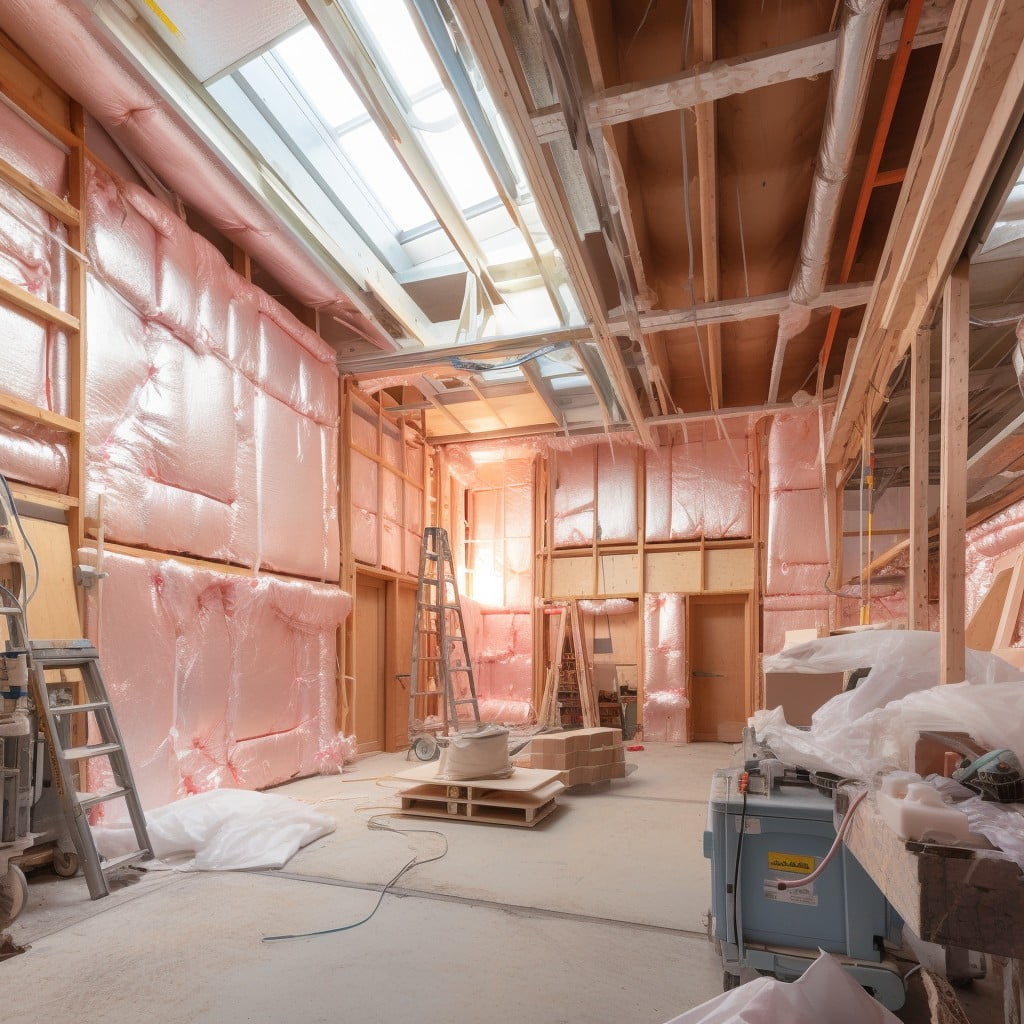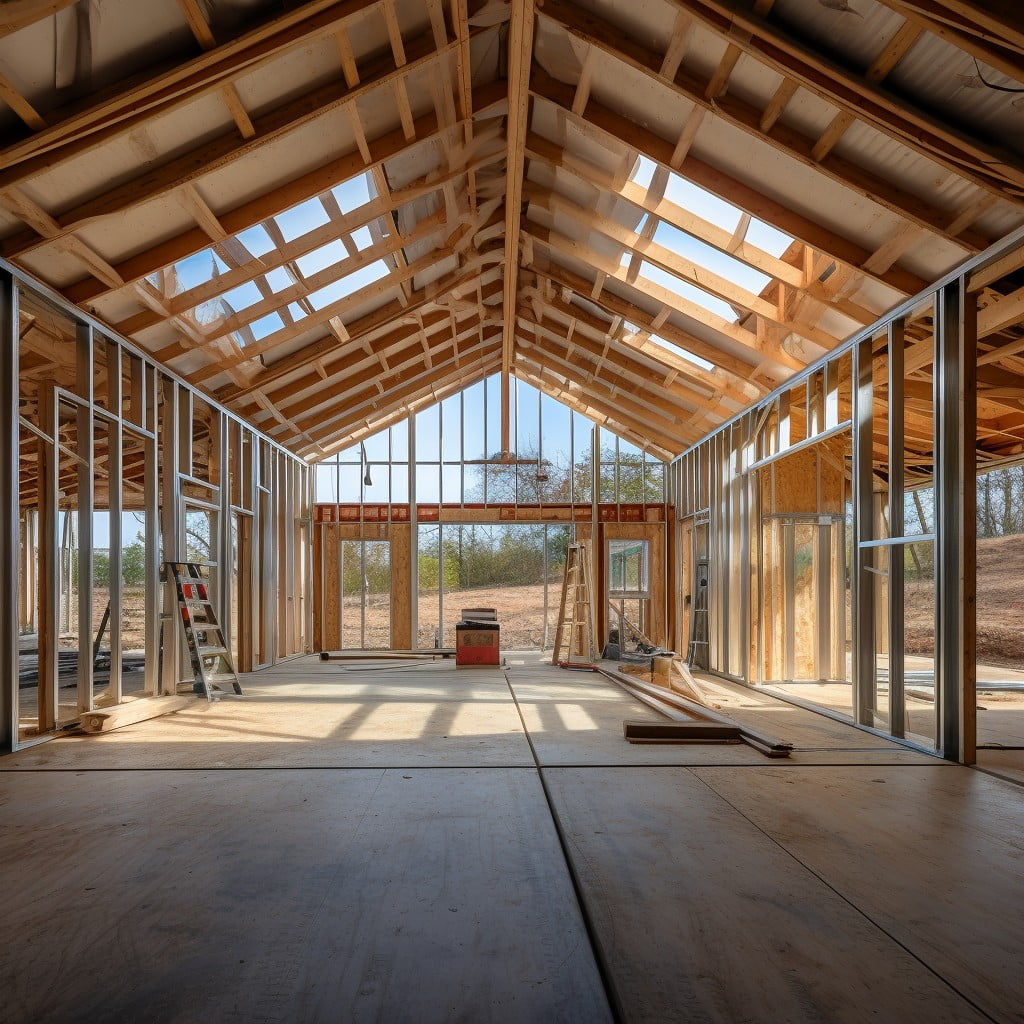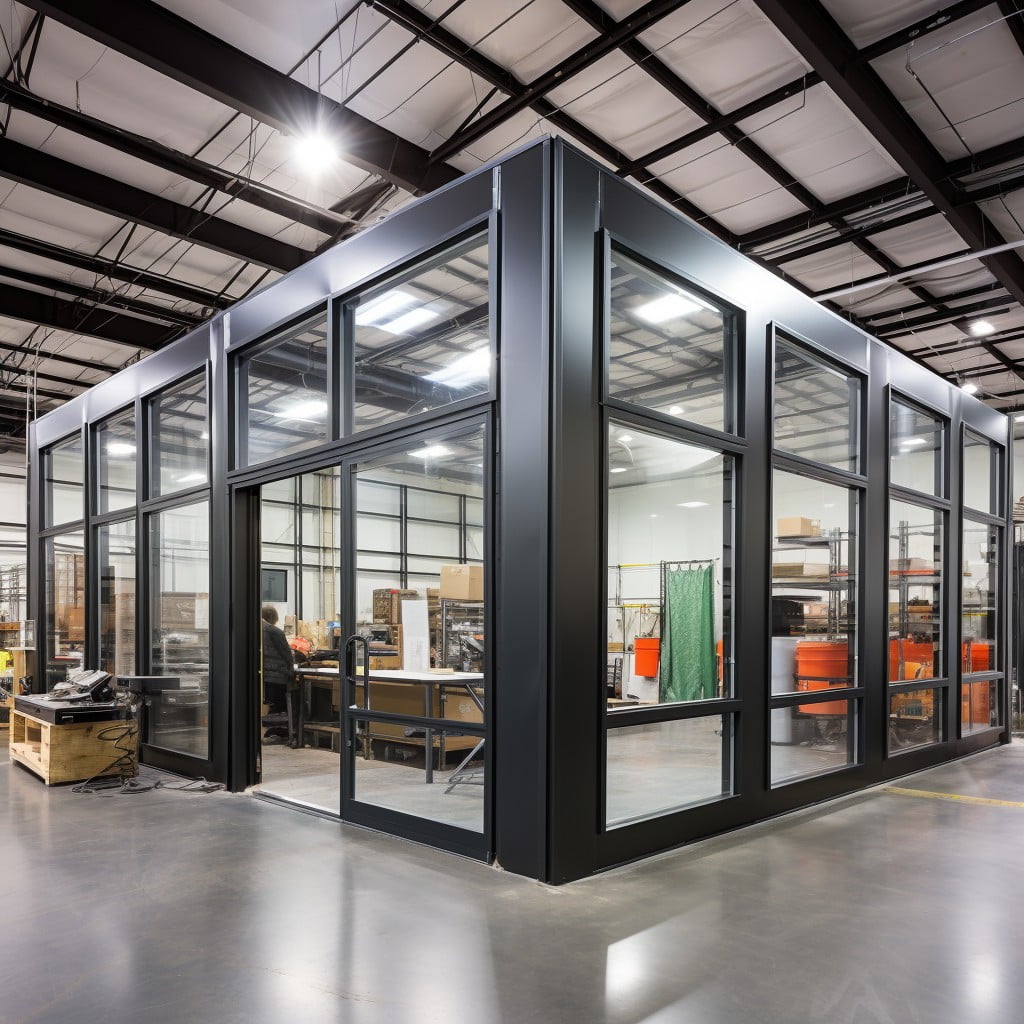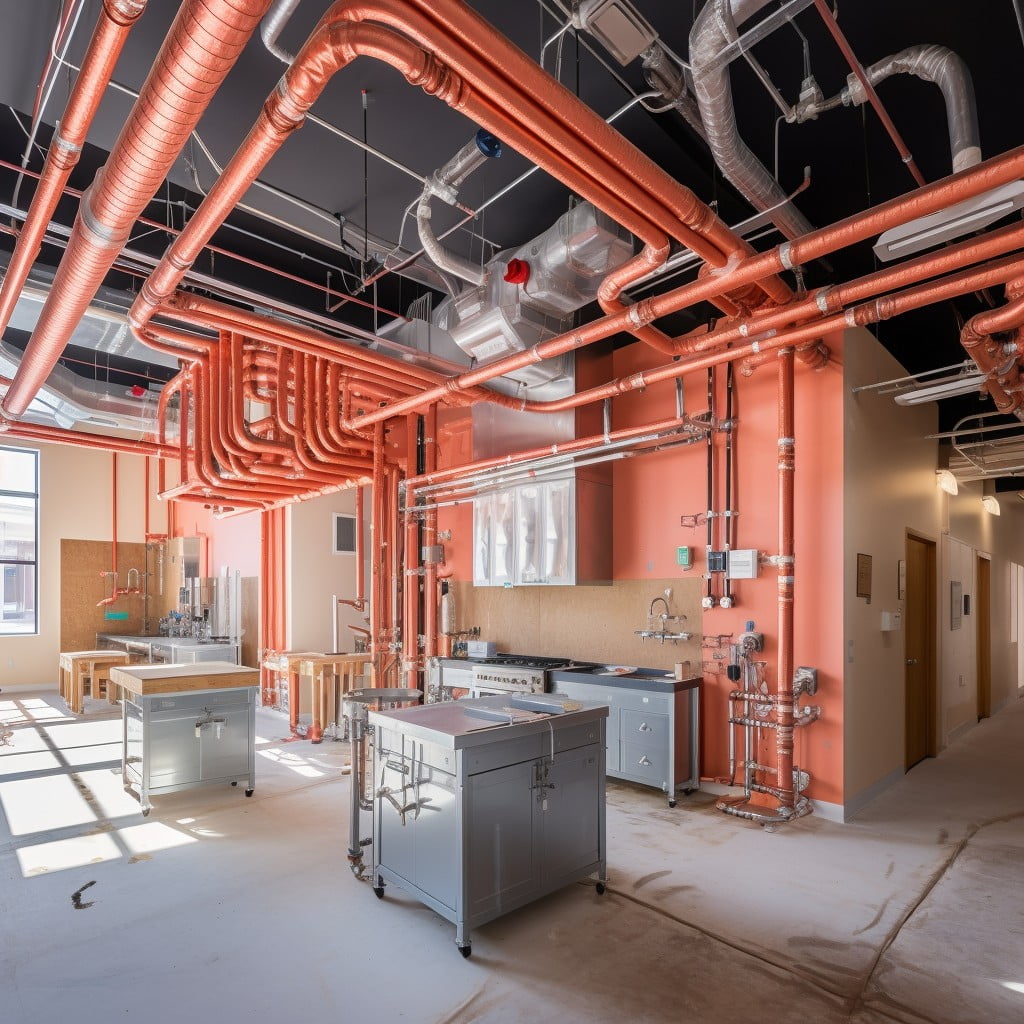Exploring various methods and steps to successfully finish the inside of a metal building can transform it into a functional, aesthetically pleasing space.
Finishing the inside of a metal building involves several steps, from insulation and framing to drywall installation and painting.
Insulation is crucial for maintaining temperature control, while framing provides the structure for drywall and other interior finishes.
After drywall installation, painting and flooring complete the process.
Understanding the sequence of these steps, the materials needed, and the techniques used is key to a successful project.
This article provides a comprehensive guide on how to accomplish each step effectively and efficiently, ensuring your metal building interior is not only aesthetically pleasing but also functional.
By following this guide, you’ll be equipped with the knowledge you need to turn your metal building into a comfortable, usable space.
Key takeaways:
- Add Insulation: Choose the right type and install properly.
- Interior Wall Framing: Consider wood or metal for structure.
- Partitioning: Create functional spaces with safety in mind.
- Wiring and Plumbing: Plan ahead and follow local building codes.
- Wall Sheathing: Choose the right material and install correctly.
Add Insulation

Insulation serves as a heat regulator for the metal building, as metal surfaces often tend to amplify temperature changes. The first step is to decide the type of insulation you want to use. The most commonly used types are blanket insulation, loose-fill, spray foam, and rigid boards. Each of these comes with distinct advantages and limitations, and the choice largely depends on your specific requirements and budget.
Remember, the insulation must be placed tightly against the wall, leaving no gaps, which could allow cold or hot air to bypass it. Make sure an adequate vapor barrier is added to prevent condensation. Pay special attention to the corners and edges, ensuring they are appropriately insulated to prevent heat loss or gain from these often-overlooked areas. Lastly, always check the manufacturer’s requirements for installing insulation to ensure optimal effectiveness.
Interior Wall Framing – Wood or Metal

When setting up the internal structure of your metal building, a fundamental decision lies in choosing between wood and metal framing. Here are some crucial points to consider for both options.
Wood framing offers several advantages, including affordability and ease of use. It’s a traditional choice that provides flexibility for alterations or repairs in the future. Many builders still favor wood due to its ability to absorb sound, potentially reducing noise levels within the structure.
Metal frames, on the other hand, are inherently strong and resistant to pests and fire. They tend to be more durable over time and are less prone to warping or rotting compared to wood. Metal studs are also lighter and more uniform, contributing to higher precision during installation. However, they require specialized tools and skills to work with.
Examining your building requirements and project budget can guide you towards the proper framing choice, ensuring a structure that is both durable and functional.
Partitioning of Your Building

Partitioning plays a critical role in categorizing and organizing spaces effectively depending on their intended function. It can be temporary or permanent and is typically designed using lightweight materials for ease of reconfiguration. Make sure the spaces flow logically.
For instance, designate an area for storage, another for operational tasks, and perhaps an office or rest space, if applicable. Bear in mind window placements for natural light and access routes when planning your partitions.
Safety should also be a priority. In certain areas, like machinery operations, carefully consider the necessity of protective barriers. For commercial settings, compliance with fire codes is paramount, meaning partitions may need to provide fire resistance.
Choose materials that best suit your needs. Metal partitions are low maintenance and highly durable, while wood partitions provide a classic look and can easily be customized with paint or wallpaper. Ultimately, flexibility in design can lead to more efficient use of your metal building’s interior space.
Wiring and Plumbing

Planning is paramount when it comes to wiring and plumbing a metal building. A key consideration is taking into account where all electrical outlets, switches, and fixtures will be located for optimization of use. Pre-cut openings in metal studs expedite electrical cabling, and running conduit for protection is highly recommended.
Plumbing should coincide with the layout of bathrooms, kitchen areas, or any other water-needs places inside the structure. It’s wise to implement cold and hot water lines as well as sewer pipes during the initial build itself. Importantly, always work in alignment with local building codes or employ licensed professionals to ensure safety standards are met. Make sure to insulate pipes to prevent heat loss or freezing in the colder months.
Remember, any alterations or additions made after the walls are fully sheathed will be costly and time-consuming, so plan ahead.
Wall Sheathing
After properly setting up your interior wall framing and ensuring the wiring and plumbing has been completed, the next part of your metal building construction project is aligning your wall sheathing. The sheathing forms a vital layer between the insulation and the final wall finish. It offers structural integrity and assists in a smoother finish installation.
You have several options to consider, including:
- 1. Drywall: It’s the most common form used in residential and commercial buildings. Its popularity stems from its affordability, ease of installation, and fire-resistant properties.
- 2. Oriented Strand Board (OSB): A more durable alternative to drywall, OSB is manufactured from waterproof heat-cured adhesives and rectangular-shaped wood strands. Its strength makes it a suitable choice for a metal building.
- 3. Plywood: Like OSB, plywood is very durable but comes at a higher cost. It’s available in a variety of finishes, perfect for those seeking aesthetic maneuverability.
Remember, it’s essential to install your sheathing correctly, using the right type of screws and ensuring they’re spaced accurately. This stage is a crucial part of building a solid, secure, and well-insulated structure.
Types of Interior Finishes
Drywall is a popular choice due to its easy installation and smooth finish. An extra benefit is its fire resistance, providing added safety. Paint or wallpaper can then be applied as per personal aesthetic preference.
Another option is interior metal paneling. This pairs perfectly with the steel frame for a complete industrial aesthetic. Options for modern, slick finishes are available in a wide spectrum of colors.
Wood paneling, for a robust and rustic appeal, can also be chosen. This finish brings a warm, inviting ambience to the space. Different types of wood have varying grains, colors, and textures, adding to the rich diversity.
For a more textured finish, one can opt for brick or stone veneer finishes. These provide an interesting contrast to the sleek metal building structure while adding a touch of grandeur.
Ceramic tiles are excellent for high moisture areas such as kitchens and bathrooms. Available in various sizes, colors, and designs, they add vibrancy to the interior space.
Remember to consider the intended use of each space while selecting the appropriate interior finish. Each comes with specific benefits and different levels of required maintenance.
Flooring
One of the significant aspects to consider in the finishing of a metal building interior is the choice of flooring. Its importance cannot be overemphasized as it significantly affects aesthetics, wear resistance and cleaning needs.
Concrete is a common choice among building proprietors due to its cost-effectiveness and durability. Embedding radiant heat within the slab provides a warm and comfy ambiance during colder months.
If you desire a more polished look, vinyl or laminate flooring is a notable option, offering a wide array of designs, colors and textures while not compromising on durability.
Alternatively, carpeting can provide a cozier, more welcoming atmosphere, though it may require more maintenance over time. Depending on its intended use, non-slip industrial grade flooring might be suitable for safety purposes.
Lastly, remember that a combination of different materials, based on the building’s zoning, could greatly enhance functionality without sacrificing style.
FAQ
Can you frame the inside of a metal building?
Yes, you can frame the inside of a metal building using more traditional materials like wood and drywall.
How do you insulate the inside of a metal building?
To insulate the inside of a metal building, spray foam insulation is commonly used, especially when metal panels are already attached to the frame and the decision has been made not to install radiant barrier insulation.
How do you make a metal building look good?
Enhancing the aesthetic of a metal building can be achieved through the integration of elements such as brick veneer, faux stone, or rock, tailored to imitate classic or modern looks, exploiting the diverse veneer options typically provided by metal building manufacturers.
What are effective methods for installing drywall in a metal building?
Effective methods for installing drywall in a metal building include using self-tapping screws to secure the drywall to the metal studs, ensuring the panels are square, using a level to check for accuracy, taping and mudding seams, and sanding for a smooth finish.
How can one optimize the interior lighting in a metal building?
To optimize the interior lighting in a metal building, incorporate strategic window placement, utilize light-reflecting colors on walls and ceilings, and install energy-efficient LED or fluorescent lighting fixtures.
What types of flooring work best inside a metal building?
Concrete, epoxy, rubber matting, or commercial-grade carpet are popular flooring choices known for their durability, strength, and easy maintenance inside metal buildings.
Recap




